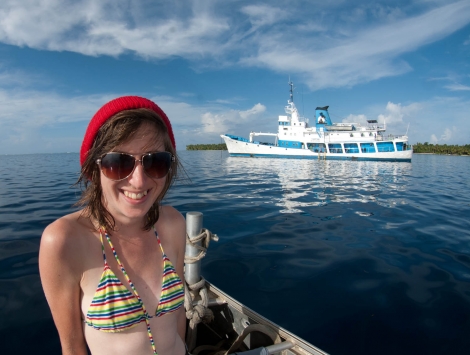Steve Lindfield, the 2008 Australasian Our World-Underwater Scholar has been doing field work in Guam for his PhD over the past 2 years. He is looking at the impacts of SCUBA spearfishing on fish populations in Micronesia as well as comparing closed circuit rebreathers and open circuit diving for fish surveys. For this, he recently received a Young Explorer’s grant from National Geographic to carry out research through the remote islands and atolls of Micronesia and invited me to help with the surveys and document the trip.
After a long night of travel I arrived in Guam’s capital, Hagåtña. Guam is an unincorporated territory of the United States and the largest and Southern most of the Mariana Islands, an island chain located in the Western Pacific. After only a few days in Guam, at the University of Guam Marine Laboratory, we flew to the island of Yap in the Federated States of Micronesia (FSM), with Marine Lab scientist and PhD student, Brett Taylor. Yap is famous for its Manta Rays and so we had to check them out! We descended down on the Manta cleaning station and watched the rays hover above the corals then fly overhead, out into the blue water and back to the reef top. It was an amazing experience to see these graceful animals in action!
While in Yap we visited the Yap Community Action Program (YapCap) and the Ministry of Marine Resources to gather information about Yap fishing regulations and to learn about the outer islands we would be visiting on our trip.
This trip we were about to embark on was with the SS Thorfinn, a 170 foot long steam engine that was built in 1950 and served as a whaling vessel in Vancouver, Canada for many years. Captain Lance Higgs bought the ship and turned it into the first recreational live aboard in the world and the first trip through Micronesia was in 1983.
We departed the following day for Sorol, and after steaming for 20 hours we arrived at the palm fringed uninhabited atoll. There we made our first fish surveys running stereo video transects along the coral reef. People from surrounding islands occasionally visit Sorol to collect turtles and coconuts but do little fishing and so the coral habitat was incredibly healthy. We saw dogtooth tuna and a plethora of large reef fish reef fish, huge sea turtles resting on the reef and a few sharks. It was great!! It was strange to come to the realisation that no one had ever dived in that location before; this really is quite an amazing opportunity – not only to see these areas but also for Steve and Brett to survey and compare untouched places to places like Guam where historical overfishing has diminished the reef ecosystems.
Next stop was Ifalik, with four villages living in relative isolation to the rest of the world and a population of 600 people. The first dive site was spectacular; a big rock wall with crevices and overhangs and a lot of sea life. We saw Sea Turtles hugging the wall, Spotted Eagle Rays flying past and clownfish dancing amongst the anemones.
In the afternoon we ventured into the main village on Ifalik to meet the locals and watch three dance groups. The dancers had made grass skirts and intricate flower decorations for the dance and we all watched, delighted, as they chanted and giggled amongst themselves. After the dancing we wandered past coconut trees, banana trees, thatched huts and leashed pigs. Eventually the stone path turned to white sand and the green trees gave way to beautiful blue water. We had walked across the small island to a picturesque beach where we drank coconuts and chewed betel nut, a Micronesian addiction made up of a small fruit, lime powder and pepper leaf.
We then steamed on to Lamotrek, a lagoon with a large area of reef, and then on to a Satawol, a small island with only fringing reef. The dives at these islands were often shallow reefs then big drop offs – this made for some stunning seascapes with large schools of fish, rocky outcrops, turtles and sharks. Coral cover was patchy and large areas were covered in green algae but the steep walls dropping into the abyss made us feel small as we cruised the walls surveying fish.
Night dives under the anchored boat finished many of the days. The clear water made it a new experience for me; night diving is one of my favourite types of diving, but never before had I had such good visibility, allowing me to see the other divers and all the way up the reef. We found sleeping pufferfish, lobster, eels and anglerfish.
The Pan-Micro Thorfinn tour ended in Chuuk Lagoon. We spent a few days here diving on the beautifully preserved Japanese World War II wrecks. It was an amazing experience diving along a 155m long cargo transporter, swimming through corridors at 25m at night, sitting in the cockpit of a fighter plane and riding tractors in the cargo hold of a British New Zealand ship that was seized by the Japanese. It was great diving on these wrecks because it bought together my new found interest in tropical reef ecology and also reinforced my passion for marine archaeology.
We said farewell to the Thorfinn, its crew of 22 and the other guests. It was a very exciting and interesting trip; I learnt a lot about reef fish identification, fish survey techniques as well as the local traditions at each of the islands and throughout Micronesia. Diving the wrecks in Chuuk also made me appreciate the significance of this area of the world during the war.
Thank you to Steve Lindfield for inviting me along and Captain Lance for supporting the scholarship.
See more photos at my Flickr site























